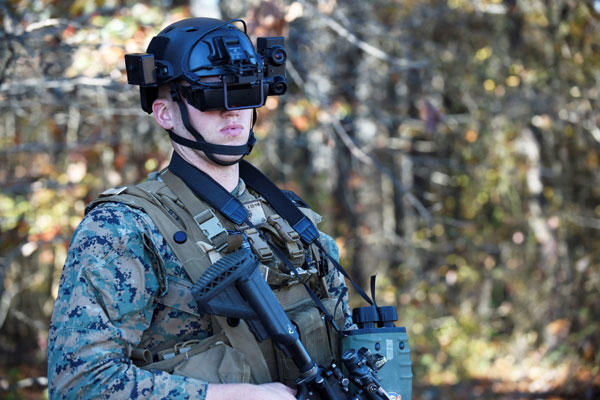Pull on a combat helmet and flip down a set of specially designed goggles. Suddenly, tanks appear in the distance on the green field in front of you, or helicopters appear out of nowhere to churn through the air. If you look through a pair of binoculars, the images are magnified, just as they would be if the vehicles and aircraft were real and not projections in a viewfinder. The whir of the rotor blades is authentic. And with a press of a controller, you can even overlay grid lines onto the ground beneath your feet to aid with calling in fire support.
It sounds futuristic, but it's technology that could be training Marines in schoolhouses across the Corps in the very near future.
Called Augmented Immersive Team Training, the system is designed to get Marines out of physically limited trainers and simulator facilities by projecting realistic training scenarios into their field of vision, wherever they are.
"Historically it has been very expensive to provide the correct visual cues in live training, close air support being one example," Col. Walt Yates, program manager for training systems at Marine Corps Systems Command told Military.com. "The fully burdened cost of aircraft can be many thousands of dollars per flight hour. All of that is necessary to train observers and controllers on the ground on the basics of their skills ... the idea behind AITT is, we now have the tools available in virtual reality to blend with the real world, seamlessly."
The AITT program transitioned from the Office of Naval Research to Marine Corps Systems Command last October. Now, SYSCOM is preparing to release a sources sought solicitation to industry before the end of this year to develop the technology from its current prototype version to something ready to field to the fleet. The Marines' Expeditionary Warfare School, artillery military occupational school, and The Basic School might all be candidates to receive the technology, Yates said.
Related Video:
Lieutenants at the Corps' Infantry Officers Course in Quantico, Virginia got a chance to test the prototype systems out last fall and offer their feedback.
"We're going to be focused on miniaturizing, ruggedizing, battery life, and improving the head-mounted display," Yates said. While a per-unit cost for the system has not been established, he said, "It's a fraction of the cost of ammunition that a single artillery battery would expend during a year of annual training requirements."
Right now, the system consists of a head-mounted display connected to a helmet and a ten-pound computer, strapped to the back via a harness, that generates the images and effects within a user's field of vision.
The idea, Yates said, is to create a "mixed reality" in which projected images blend seamlessly with real, physical objects and scenery. With the help of technology that automatically adjusts brightness and contrast, the result is a real-feeling battlespace with very little to distinguish simulated effects from authentic ones.
The concept originated with the legendary retired Marine Gen. James Mattis, who proposed a similar training tool while he was the head of U.S. Joint Forces Command in 2009, Yates said.
"Our vision was ahead of the current state of technology," he said. "We had to wait for commercial technology to catch up with the vision."
Today, with virtual reality headsets like the Oculus Rift available for commercial use, it's a different story.
Yates said he foresaw the Marine Corps fielding the system to "those members of the squad and company fire support team that are eyeballs and sensors on the battlefield," including forward observers, forward controllers, joint terminal attack controllers and scout observers.
But eventually, he said, the technology can be adapted to those training with light armored vehicles, amphibious assault vehicles and tanks, or even unmanned aerial systems training.
"It's going to be one of those cases where, when you put a piece of new technology we haven't had in the past, it's going to generate a lot of new ideas," he said.
-- Hope Hodge Seck can be reached at hope.seck@monster.com. Follow her on Twitter at @HopeSeck.




























